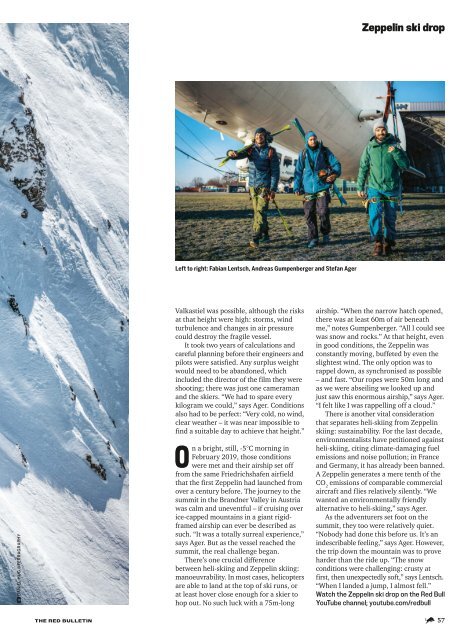The Red Bulletin February/March 2020 (UK)
- No tags were found...
You also want an ePaper? Increase the reach of your titles
YUMPU automatically turns print PDFs into web optimized ePapers that Google loves.
Zeppelin ski drop<br />
Left to right: Fabian Lentsch, Andreas Gumpenberger and Stefan Ager<br />
DANIEL HUG @TERRAGRAPHY<br />
Valkastiel was possible, although the risks<br />
at that height were high: storms, wind<br />
turbulence and changes in air pressure<br />
could destroy the fragile vessel.<br />
It took two years of calculations and<br />
careful planning before their engineers and<br />
pilots were satisfied. Any surplus weight<br />
would need to be abandoned, which<br />
included the director of the film they were<br />
shooting; there was just one cameraman<br />
and the skiers. “We had to spare every<br />
kilogram we could,” says Ager. Conditions<br />
also had to be perfect: “Very cold, no wind,<br />
clear weather – it was near impossible to<br />
find a suitable day to achieve that height.”<br />
On a bright, still, -5°C morning in<br />
<strong>February</strong> 2019, those conditions<br />
were met and their airship set off<br />
from the same Friedrichshafen airfield<br />
that the first Zeppelin had launched from<br />
over a century before. <strong>The</strong> journey to the<br />
summit in the Brandner Valley in Austria<br />
was calm and uneventful – if cruising over<br />
ice-capped mountains in a giant rigidframed<br />
airship can ever be described as<br />
such. “It was a totally surreal experience,”<br />
says Ager. But as the vessel reached the<br />
summit, the real challenge began.<br />
<strong>The</strong>re’s one crucial difference<br />
between heli-skiing and Zeppelin skiing:<br />
manoeuvrability. In most cases, helicopters<br />
are able to land at the top of ski runs, or<br />
at least hover close enough for a skier to<br />
hop out. No such luck with a 75m-long<br />
airship. “When the narrow hatch opened,<br />
there was at least 60m of air beneath<br />
me,” notes Gumpenberger. “All I could see<br />
was snow and rocks.” At that height, even<br />
in good conditions, the Zeppelin was<br />
constantly moving, buffeted by even the<br />
slightest wind. <strong>The</strong> only option was to<br />
rappel down, as synchronised as possible<br />
– and fast. “Our ropes were 50m long and<br />
as we were abseiling we looked up and<br />
just saw this enormous airship,” says Ager.<br />
“I felt like I was rappelling off a cloud.”<br />
<strong>The</strong>re is another vital consideration<br />
that separates heli-skiing from Zeppelin<br />
skiing: sustainability. For the last decade,<br />
environmentalists have petitioned against<br />
heli-skiing, citing climate-damaging fuel<br />
emissions and noise pollution; in France<br />
and Germany, it has already been banned.<br />
A Zeppelin generates a mere tenth of the<br />
CO 2<br />
emissions of comparable commercial<br />
aircraft and flies relatively silently. “We<br />
wanted an environmentally friendly<br />
alternative to heli-skiing,” says Ager.<br />
As the adventurers set foot on the<br />
summit, they too were relatively quiet.<br />
“Nobody had done this before us. It’s an<br />
indescribable feeling,” says Ager. However,<br />
the trip down the mountain was to prove<br />
harder than the ride up. “<strong>The</strong> snow<br />
conditions were challenging: crusty at<br />
first, then unexpectedly soft,” says Lentsch.<br />
“When I landed a jump, I almost fell.”<br />
Watch the Zeppelin ski drop on the <strong>Red</strong> Bull<br />
YouTube channel; youtube.com/redbull<br />
THE RED BULLETIN 57

















